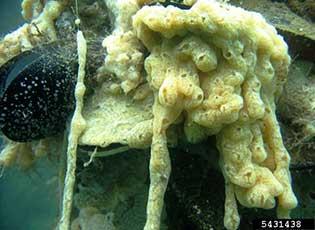Didemnum vexillum Kott, 2002 (Stefaniak et al. 2009)
Colonial sea squirt, ascidian, colonial tunicate, compound sea squirt, carpet sea squirt
Unknown, possibly Japan (Lambert 2009)
First confirmed sighting in 1993 (Lambert 2009)
Introductions likely due to shipping (either via hull or sea chest fouling) (Lambert 2009)
Forms dense colonies that can smother native species (Bullard et al. 2007)
Coastal New England, Coastal Pacific Northwest

Sea squirt, adult
Photo by U.S. Geological Survey
Find more images
Videos
All Resources
Selected Resources
The section below contains highly relevant resources for this species, organized by source.
Council or Task Force
Partnership
Federal Government
International Government
State and Local Government
Bullard, S.G., G. Lambert, M.R. Carman, J. Byrnes, R.B. Whitlatch, G. Ruiz, R.J. Miller, L. Harris, P.C. Valentine, J.S. Collie, J. Pederson, D.C. McNaught, A.N. Cohen, R.G. Asch, J. Dijkstra, and K. Heinonen. 2007. The colonial ascidian Didemnum sp. A: Current distribution, basic biology and potential threat to marine communities of the northeast and west coasts of North America. Journal of Experimental Marine Biology and Ecology 342(1):99-108.
Lambert, G. 2009. Adventures of a sea squirt sleuth: unraveling the identity of Didemnum vexillum, a global ascidian invader. Aquatic Invasions 4(1):5-28.
Stefaniak, L., G. Lambert, A. Gittenberger, H. Zhang, S. Lin, and R.B. Whitlatch. 2009. Genetic conspecificity of the worldwide populations of Didemnum vexillum Kott, 2002. Aquatic Invasions 4(1):29-44.
